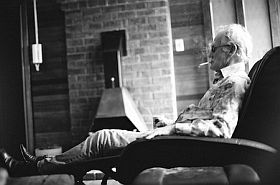


Liechti: Father’s Garden – The Love of My Parents
“For heaven’s sake – what a question!” utters Hedi as her son starts the conversation that they had avoided for decades. Father’s Garden – The Love of My Parents is a new documentary film by Swiss director Peter Liechti that traces a close re-encounter of Peter with his comely aged parents, Max and Hedi Liechti. The film is based on 20 interviews of his parents, taken between summer of 2010 and summer of 2011. Everything that appears in the film is verbatim from these conversations.
A couple of minutes into the film, Peter spills a story of an accidental public encounter with his father a few years back. Despite having not seen one another for ages, the two could not embrace. The happenstance perplexed Peter, compelling him to take a closer look at his parents, hence resulted in the following film. After the long absence from his parents’ lives, Peter plunges himself into their biographies allowing every moment, no matter how mundane, to reveal disjointed entrails of their subjective memories. Circumventing the comforts of silence, this author-driven documentary attempts to explore the dark corners of his parents’ bygone days and resurface things long forgotten through the scrupulous recollection of the common past.
Unsentimental yet empathetic, the film centers upon the difficult marriage of Max and Hedi, who have lived together for 62 years. “Closely knit yet poles apart” – as Berlinale put it – the two are just fundamentally different. “Mother loves to travel. […] I am just a homebody. She reads a lot. I
only read a newspaper. I like to be with people, in sports clubs and whatnot. And she prefers being alone.” The two have conflicting views and interests in almost everything to the degree that as Hedi divulges, “[…] it is almost a miracle that we are still together.”
Recipient of the Visions du Réel 2013 Special Prize of the Jury SSA/Suisssimage for the most innovative Swiss feature film, Father’s Garden – The Love of My Parents masterfully utilizes a puppet theater as a confessional for Max and Hedi to let their inner struggles play out in the outer terrains. Peter does not shine away from tackling issues that are particularly sensitive to his parents – religion, love, war, or their unfulfilled dreams. The inquisitive long-absent son is like that “unwelcome archaeologist”, who stirs up cold ashes and unearths buried residues of the past family conflict that has run out of arguments. Yet, Peter embraces the confrontation. He asks: “If you had the chance, would you choose a son like me again?” which not only comes to disrupt the long silence but also creates tension in the already complex dynamics of his family. Crying for relief, the suspended tension is released as the defiant son, presented as a puppet alike his parents, reacts in the frenzy manner accompanied by the blaring electro sounds. I believe that employment of the puppet theater within the documentary format deems prolific in telling the multi-faceted story of Peter’s family.
From the vantage point of the beholder, however, I descry larger topics the film explores that go beyond the Liechti’s personal narrative. As Max and Hedi, who one would classify as to belonging to the lower middle-class, are presented as puppet hares in shirts and aprons, the film seems to sketch the perceived scape of normalcy of the old system and the people’s over-fixation on the order of things, be it Max’s utmost precision while tending the garden or Hedi’s habit to put her housekeeping money in petite paper drawers “Leisure”, “Guests”, “Gifts”, and etc.
Revolving around the concept of normality, Max also ascertains the role of a woman in a family and the society at large: “By her very nature a woman doesn’t belong in the work process. [If the wife works], then this, in my opinion, is evading the normality. Sooner or later one just has to accept it and assign her task in life accordingly. […]” Lukewarm in convictions, Hedi does not rail against the established tenet of her role. Yet her longings break out through her quietness in innumerable curious ways: “Florence, Michelangelo, the Acropolis. He never had dreams like I did. […] So I withdrew, retreated, and immersed myself increasingly in books. […]”
Peculiarly unsettling, eerie. The film comes to revisit not only the past – it also probes landing its foot on the dreamscape and not so distant future. “As the firmament gets closer and closer”, the concept of time seems captivated within the recurrent dreams of the protagonists: “I always dream the same dream,” shares Hedi. […] It is a beautiful place in the Alps. Perhaps, in Bernese Oberland. The building is old and complex… And when I want to leave, I don’t have enough time to pack before the next guests arrive. Like in the hospital. I can never finish anything. Nothing at all.”
At times provocative but always with much candor, Father’s Garden – The Love of My Parents deftly explores the metaphysics of the human spirit. Most importantly, however, I find that the film shows a due reverence to the old age, where love becomes stronger between the ones that have been poles apart.
Switzerland, 2013, 93 min.

